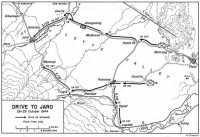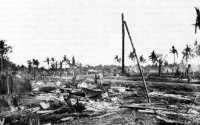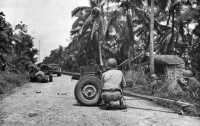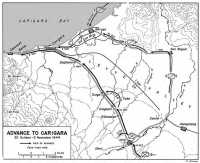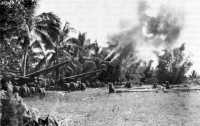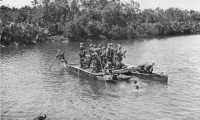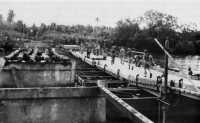Chapter 10: Northern Leyte Valley: Part Two
General Krueger had expected stronger Japanese resistance in the zone of action of the 1st Cavalry Division than in that of the 24th Division. He had therefore thought it safe to release the 21st Infantry for the landings at Panaon Strait. When events proved otherwise, a portion of the strength of the 1st Cavalry Division was shifted into the zone of the 24th Division to enable the latter to free itself of responsibility for rear areas and direct its effort to the advance into Leyte Valley.1 (Map 9)
Drive up Leyte Valley
The Japanese planned to fall back into the mountains if the Americans were successful in seizing the Tacloban airfield. They expected to take with them “munition sufficient for one and one-half units of fire for one division ... and food for 20,000 men for six month[s].”2 The rapid advance of the Americans, however, prevented the execution of this plan. After 25 October the remaining elements of the 33rd Infantry Regiment withdrew to a position about three and three-fourths miles northeast of Jaro.3 When the American forces had taken the hills dominating the entrance into Leyte Valley and overlooking Highway 2, Lt. Gen. Sosaku Suzuki, the commander of the 35th Army, concentrated his forces around Jaro on the southern edge of Leyte Valley. The 41st Regiment of the 30th Division and the 169th Independent Battalion of the 102nd Division, both of which had but recently arrived on Leyte as reinforcements to the 16th Division, on 26 October were ordered to proceed from Carigara to Jaro. On the same day the 17th Independent Battalion, 102nd Division, moved toward Jaro.4
The 34th Infantry Advances Into the Valley
After the successful capture of Hills B and C, the 24th Division resumed its attack west. With the 1st Cavalry Division protecting the 24th Division’s northern flank, the 34th Infantry was to proceed westward into the interior along Highway 2. The 19th Infantry, as the 24th Division’s southern prong, was to follow an almost parallel route to Pastrana.5 The 1st Cavalry Brigade was to relieve the combat troops of the 24th Division in the rear areas in order to enable the division to continue its advance into the interior.
Highway 2 was a one-lane all-weather road, twelve feet wide with four-foot shoulders. It had a crushed rock and gravel
Map 9: Drive to Jaro 26–29 October 1944
surface. In general it ran through level ground, with occasional groves of light timber, bamboo, and abaca. Much of the area was under cultivation. At Santa Fe a one-lane all-weather branch road ran four miles south to Pastrana, at which point a seasonal one-lane road ran southward for about five miles to Dagami and another northwest for about eight and a half miles to Jaro.
At 1000 on 26 October the 2nd Battalion of the 34th Infantry, commanded by Colonel Pearsall, moved out of its assembly area at Malirong in a column of companies and pushed westward on Highway 2. The battalion met slight resistance at the Malirong River bridge, but mortar fire knocked out the enemy opposition, and the advance continued. Since the battalion encountered few Japanese, the flank protection, which had to traverse difficult terrain, was called in, and the advance then proceeded at a much more rapid pace. The 2nd Battalion met, and killed or routed, small groups of the enemy. It crossed streams where the bridges had been destroyed. The 3rd Engineer Battalion put temporary structures in for two of these bridges in order that the first elements might proceed, and it placed a Bailey bridge over a third stream. The 1st Battalion, which followed the 2nd, used Japanese handcarts to transport supplies between the destroyed bridges and the forward troops.6 By 1730 Colonel Pearsall had all of his battalion in Sante Fe. The following day, Lt. Col. Thomas E. Clifford, Jr., who had become
the commanding officer of the 1st Battalion, pushed his unit through the 2nd Battalion and advanced 7,000 yards without opposition to the Mudburon River, where the troops established their night perimeter at 1545.7
Mainit River Bridge
On the morning of 28 October Colonel Clifford ordered the 1st Battalion to move out in a column of companies along Highway 2 toward the town of Alangalang about a mile and a quarter northwest. At 0900 the battalion moved out. Company A, the lead company, entered Alangalang without incident, set up local security, and then fell to the rear of the battalion, which passed through Alangalang8 without pausing and moved toward the Mainit River about one and a half miles farther on.
As Company C reached the Mainit River it made contact with the enemy, who had dug in on both steeply sloping banks of the river at the steel bridge crossing. The company suffered five casualties. It was opposed by the remaining elements of the 33rd Infantry, which had been considerably mauled by the Americans.9 Company C withdrew 300 yards as Companies B and A pressed forward on the left side of the road under continuous rifle fire. Colonel Pearsall’s 2nd Battalion had followed the 1st Battalion, and both units were to make an assault against the 41st Infantry Regiment, which had arrived in the area. Three batteries of the 63rd Field Artillery Battalion shelled the enemy positions for a depth of 300 yards on the eastern side of the river and 100 yards on the western side.
After the artillery concentration was over, the two battalions were to move out to the attack – the 1st on the left and the 2nd on the right. The regimental commander ordered the 1st Battalion to attack, destroy the enemy resistance, and secure the eastern bank of the river. Five tanks were to follow in the rear of the assault companies and fire at targets of opportunity. Five hundred yards away, to the right of the 1st Battalion, Companies E and F of Pearsall’s battalion were to cross the river, destroy enemy resistance on the western side, and then go south on Highway 2 to contact the enemy at the bridge.10
The 1st Battalion moved to the water’s edge, where it was pinned down by enemy fire. Companies E and F of the 2nd Battalion, however, were able to push north 500 yards through the heavy brush, and amid a driving rain they managed to ford the river unobserved. Once on the other side they charged the entrenchments of the 41st Infantry Regiment on the river, with Company F in the lead. As Company F neared the bridge it overran three mortar positions without stopping but was finally halted by heavy machine gun fire. After the company’s 60-mm. mortar had knocked out the machine gun, the unit continued to advance and passed the bridgehead before it ran out of ammunition. Company E then relieved Company F, while the latter set up heavy machine guns to silence enemy machine guns in the woods to the west. By 1500 the bridge was in American hands. The Japanese had placed a demolition
charge on the bridge, but the American advance had been so swift that the enemy never had an opportunity to set off the charge.
The 3rd Battalion had meanwhile moved up to the rear of the other two battalions and established contact south of Santa Fe with the 19th Infantry, which was protecting the southern flank of the division.
Seizure of Pastrana
On 25 October the 3rd Battalion, 19th Infantry, advancing toward Pastrana, had pushed against slight opposition into Castilla and established a perimeter there.11 On the morning of the same day, Maj. Elmer C. Howard, the battalion commander, told Lt. Col. George H. Chapman, Jr., of the 19th Infantry that he had learned from the Filipinos that there was no organized resistance along the three miles from Castilla to Pastrana. He therefore asked permission to go to Pastrana and establish a roadblock. Colonel Chapman told Major Howard to stay out of Pastrana but to send patrols to locate defenses around the town.12 Colonel Chapman later rescinded this order, and at 1300 on 26 October Major Howard moved his battalion out from Castilla to attack Pastrana, which was 5,000 yards southwest of Santa Fe. Company I, the lead company, proceeded over a trail that was too narrow to accommodate vehicles. At 1600 the point of Company I reached the outskirts of Pastrana but came under heavy enemy fire. The battalion pulled back and then attacked with Companies I and K abreast. The companies were stopped by fire that came from an unusual fortification – a star-shaped fort, with a tin roof, which looked like three or four native shacks in a cluster. The sides were banked with earth, over which grass had been allowed to grow – a feature so exceptional that it aroused suspicion and gave away the nature of the installation. Pillboxes flanked the fortification, which was backed by a system of trenches. Colonel Chapman ordered another attack at 1630, but casualties were so heavy that the troops dug in after getting within 100 yards of the fortress.
At 1750 Battery C, 11th Field Artillery Battalion, placed fire on the fortification, but after forty-two rounds of ammunition had been expended, the battery reported that the muddy ground “caused [the] guns to go out of action.”13 From 1850 to 1905, Battery A of the 14th Field Artillery delivered harassing fire on Pastrana,14 and from 2200 to 2400 the 13th Field Artillery Battalion took over the task of placing fire on the sector around the town.15 With the coming of daylight, the 4.2-inch and 81-mm. mortars took up the shelling. The night-long pounding of the Japanese positions around Pastrana was so effective that on the morning of 27 October Company K of the 3rd Battalion was able to move around the town and establish a roadblock at a demolished bridge a few hundred yards southwest. The rest of the day the 3rd Battalion, assisted by Colonel Zierath’s 1st Battalion, which had followed the 3rd Battalion, mopped up in the town and sent out patrols to investigate the terrain and enemy dispositions west and south of the town.
The 19th Infantry was to continue to protect the southern flank of the 24th Division,
Pastrana was left a mass of smoldering ruins after the shelling of 26–27 October
which was driving toward Carigara, by moving toward Jaro – the proposed assembly point of the 35th Army, On the morning of 28 October, Colonel Zierath had the 1st Battalion establish a roadblock north of the Binahaan River in the vicinity of Macalpe. The 2nd Battalion pushed forward to Tingib and established a perimeter there. For the next two days the 19th Infantry sent out patrols in all directions; they met only scattered resistance from the Japanese. On 29 October Company K left Pastrana and established a roadblock at Ypad. On the following day it moved south from Ypad to Lapdok, where it established contact with elements of the XXIV Corps. On the 30th two platoons from Company C encountered about 100 Japanese at Rizal. The enemy fought aggressively, but resistance ceased after artillery fire had been placed on the town. It was estimated that the majority of the enemy force was killed. As a result of the skirmishes and patrols, General Makino was unable to establish contact between elements of the 16th Division at Dagami and those at Jaro.16
Fall of Jaro
At the crossing of the Mainit River, a one-lane all-weather branch road runs southwest for about three and a half miles to Jaro, and then northwest along the western edge of Leyte Valley for about ten and a half miles to Carigara on the north coast. At Jaro many dirt roads and trails branch out in all directions.
The drive of the 24th Division toward Carigara was continued as the 34th Infantry,
protected by the 19th Infantry on its flank, moved toward Jaro. After the seizure of the Mainit River bridge, two tanks of the 1st Platoon, 603rd Tank Company, attached to the 34th Infantry, scouted north and made contact with forward elements of the 2nd Squadron of the 8th Cavalry, which had arrived in the San Miguel area.
On the evening of 28 October Colonel Newman issued orders to the 34th Infantry for the following day. The 3rd Battalion, under Lt. Col. Edward M. Postlethwait, was to pass through Colonel Clifford’s 1st Battalion and Colonel Pearsall’s 2nd Battalion and resume the offensive with Company L in the lead. From Cavite the battalion would move southwest along the road to capture Jaro. Company L would be sufficiently in advance to make reconnaissance of the route before the rest of the battalion arrived.17
At 0900 on 29 October, Company L moved out from Cavite, meeting no resistance until an hour later when it ran into some of the enemy at a point about 100 yards from Galotan.18 The leading scout spied a man, whom he thought to be a Filipino, dashing into a shack. When he shouted for the man to come out, the scout was shot in the head. The company came on and killed the man. It then came under machine gun fire. Platoons attacked from both flanks against Galotan. Since the enemy troops had dug in under the shacks, it was slow, bloody work digging them out with rifles and grenades. The 3rd Platoon, which had been in reserve, closed in when the center of the town was reached and helped finish the job. In the meantime another unit of the company. which had been sent to the right on a wide enveloping movement, came under fire from a wooded knoll. Artillery and mortar fire soon drove the Japanese off. Unable to retreat westward, the enemy moved northward down a stream bed and set up a defensive position 500 yards west of the road and opposite the center of the advancing column of the 3rd Battalion. Fortunately, since the Antitank Platoon had displaced forward by sections, one section was in position at this point and was able to quickly eliminate the enemy threat. The 3rd Battalion resumed its march and secured Jaro at 1700 without further difficulty.
By this time the 19th Infantry had gained control of the area south and east of Jaro. Junction between the 34th Infantry and 19th Infantry was accomplished on 31 October when the 1st Battalion, 19th Infantry, moved into Jaro. Other elements of the 19th Infantry were engaged in mopping up in the Pastrana sector. The 19th and 34th Infantry Regiments had been able to advance rapidly in their drives through Leyte Valley, had maintained contact with the 1st Cavalry Division, and had arrived within ten miles of Carigara Bay.
By 28 October the XXIV Corps had nearly secured the southern portion of Leyte Valley. General Sibert was anxious to have the X Corps advance rapidly to the shore of Carigara Bay and thus bring all of the valley under control of the Sixth Army. The 24th Division was relieved by the 1st Cavalry Division of responsibility for protecting the rear areas from Santa Fe to Cavite. The 24th Division, thus freed, was to continue pressing the attack to its front with the utmost vigor.19
The American advance had been so rapid that General Suzuki did not have sufficient time to put into effect his plan
U.S. antitank platoon under enemy fire at Jaro. Soldier in foreground is taking cover behind a 37-mm. antitank gun M3
for making Jaro the assembly ground for the 35th Army. He was forced to use the Carigara area as the new point of rendezvous for his troops. On the evening of 28 October Colonel Newman planned his attack for the remaining distance to Carigara. He hoped that the troops would make a swift passage, but later events proved that the Japanese intended to contest the advance bitterly.
Drive From the North
At the close of 27 October the 7th Cavalry, less the 1st Squadron, was in reserve, while the 1st Squadron was at Babatngon sending patrols along the north coast of Leyte and the southwest coast of Samar. The 1st Squadron of the 8th Cavalry was patrolling Samar in the La Paz area and the 2nd Squadron of the regiment was patrolling from its bivouac area in the upper reaches of the Diit River. In order to protect the rear of the 24th Division in its forward advance, the 1st Squadron of the 12th Cavalry, which had been in reserve, was ordered to Castilla. The squadron closed on Castilla at 1200 on 28 October.20
In accordance with orders from General Sibert, General Mudge reassigned the various elements of the 1st Cavalry Division. On 28 October General Hoffman issued orders for his 2nd Cavalry Brigade to move toward Carigara. The 2nd Squadron, 8th Cavalry, was to establish a base at San Miguel, secure Cavite with one troop, patrol and mop up the north and northwest
area up to and including the Barugo road, and maintain contact with patrols of the 1st Squadron, 7th Cavalry, that would be operating southeast from Barugo. The 1st Squadron, 7th Cavalry, while maintaining a platoon at Santa Cruz and a troop at Babatngon, was to move to the Barugo-Carigara area and mop up and patrol the area to the south and southeast.21
In accordance with this plan, Troop C of the 7th Cavalry was to proceed by water from Babatngon to Barugo and then overland to feel out the enemy position in Carigara. Troop C, under 1st Lt. Tower W. Greenbowe, on 28 October made the overwater and overland movements without incident. The troop entered the eastern end of Carigara without opposition, but as it neared the main intersection it received fire from several buildings. In anticipation of this contingency, the men of Troop C had been well deployed when they entered the town, and were able to return the fire immediately. As the fight progressed, the Japanese transported their dead and wounded to five trucks near the beach road. The fire fight continued until late in the afternoon when Lieutenant Greenbowe withdrew his force to Barugo, and evacuated his dead and wounded with him. The enemy had suffered an estimated 75 casualties; Greenbowe’s force had 3 men killed, 9 wounded, and 1 missing. The mutilated body of the missing man was found later.22
Since intelligence reports stated that as many as 5,000 Japanese were in Carigara, General Sibert decided that the attack on the town should be a two-division operation. While the 24th Division was fighting its way up the road from Jaro to Carigara, additional 2nd Cavalry Brigade units assembled in the Barugo area. The 1st Squadron of the 7th Cavalry joined its C Troop at Barugo on 29 October; the 2nd Squadron, 8th Cavalry, moved from San Miguel to Barugo on 31 October; and the advance headquarters of the 7th Cavalry Regiment and the 2nd Cavalry Brigade arrived at Barugo on 31 October and 1 November, respectively. Attached to the 7th Cavalry Regiment was the 2nd Squadron, 5th Cavalry, which closed into the Barugo area on 1 November via Cavite and San Miguel.23
Drive to Tunga
On 29 October the Japanese had prepared new plans for the defense of Leyte. In order to simplify planning, the 35th Army headquarters was relieved of command responsibility for Samar by the 14th Area Army. Almost simultaneously, the 35th Army received the erroneous report that the Japanese naval forces had destroyed a large part of the U.S. Navy on 24 and 25 October in engagements off Leyte and that the losses would prevent the Americans from continuing the operation. On the contrary, the American naval forces had secured a decisive victory. The Japanese reverse seriously affected General Suzuki’s attempt to put his new plans for the 35th Army into effect.
The plans provided for the calling up of the 102nd Division from Panay and the 1st and 26th Divisions from Luzon. These divisions were to land at Ormoc and then proceed
in three columns northward along Highway 2 through Ormoc Valley to the shores of Carigara Bay. They were then to advance eastward and destroy the American forces in the area between Tacloban and Tanauan. Since it was assumed that Carigara would remain in Japanese hands, the 68th Brigade, serving as 35th Army reserve, was expected to land in the north in the vicinity of Carigara. At the same time the 30th Division was to land at Albuera on the west coast and drive overland to Burauen, in order to support the operations of the main body of the 35th Army.24
Although the American naval victory and rapid advance of land forces prevented the Japanese from bringing this plan to full fruition, sizable enemy forces opposed the drive of U.S. troops toward Carigara. About 28 October the 41st Infantry Regiment moved from Carigara to the southeast section of Jaro. The 169th Independent Infantry Battalion of the 102nd Division, together with a battalion ( Tempei Battalion) of the 57th Independent Mixed Brigade, was in the Carigara area. The advance elements first engaged the Americans about 30 October.25 These units, however, continued out past Jaro and took up positions in the mountains.
On the night of 29 October the 34th Infantry had captured Jaro and was about ten miles from Carigara along the Jaro-Carigara highway. (Map 10) At 0800 on 30 October Colonel Newman ordered the 3rd Battalion of the 34th Infantry to start for Carigara down the highway. As the battalion left the outskirts of Jaro, with Company L in the lead, it came under fire from Japanese who were dug in under shacks along the road. Upon a call from the commanding officer of Company L, the tanks came up in a column, fired under the shacks, and then retired. The leading platoon was drawn back so that artillery fire might be placed on the Japanese, but the enemy could not be located precisely enough to use the artillery. Colonel Newman then ordered a cautious movement forward without artillery support, a squad placed on each side of the road and two tanks in the center. The squads had advanced only fifty yards when Japanese fire again pinned them down.
When Colonel Newman came forward and discovered why the advance was held up he declared, “I’ll get the men going okay.”26 Upon hearing that the regimental commander was to lead them, the men started to move forward. The Japanese at once opened fire with artillery and mortars, and Colonel Newman was hit in the stomach. Although badly wounded he tried to devise some means of clearing the situation. After sending a runner back with orders to have Colonel Postlethwait fire on the Japanese position, he said, “Leave me here and get mortar fire on that enemy position.”27 As soon as possible Colonel Newman was put on a poncho and dragged back to safety.28
Meanwhile the troops, unable to move forward, broke contact with the Japanese in an orderly fashion. Lt. Col. Chester A. Dahlen, the regimental executive officer, assumed command and at 1209 ordered that the attack be resumed.29 The 3rd Battalion was to move northwest along the road to Carigara for 3,000 yards and then set up a night perimeter. The 2nd Battalion, in support
Map 10 Advance to Carigara 30 October-2 November 1944
astride the highway, was to secure the high ground 500 yards northwest of Jaro, while the 1st Battalion was to move to the town of Jaro from its position at the Mainit River bridge.
The artillery concentrated its fire on the area to the front, and at 1230 the 3rd Battalion renewed the attack with Company K on the left of the road and Company I on the right. After the troops had proceeded about 200 yards, heavy artillery, machine gun, mortar, and rifle fire pinned them down. Company L in the rear thereupon attempted a flanking movement to the left across an open field but came under heavy fire from a ridge that commanded the road. All the companies were forced to pull back. At the end of the day’s action, the forward elements were still on the outskirts of Jaro.
During the night, the 11th, 52nd, and 63rd Field Artillery Battalions fired continuously in support of the 34th Infantry. The corps artillery placed harassing and interdiction fire along the Jaro-Carigara road.30
On the morning of 31 October Colonel Dahlen ordered the 3rd Battalion to move toward Tunga along the Jaro-Carigara road. The 2nd Battalion was to pass through
the 3rd along the highway, and the 1st Battalion was to be prepared to follow the 2nd.31 The 19th Infantry was to protect the rear of the 34th Infantry and forestall any attempt by the Japanese to send reinforcements from north of the Binahaan River. The 1st Battalion, 19th Infantry, was to move to Jaro via Tingib and Macanip to assist the 34th Infantry.32
At 0820 the 3rd Battalion, 34th Infantry, supported by the 2nd Battalion, attacked along the Jaro-Carigara highway. Company L went down the highway and then to the rear of the hill from which it had been repulsed the previous day; Company I moved forward astride the road; and Company K was in reserve. As advanced elements of Company I reached a stream, they came under intense fire but moved to a position from which they could attack the reverse slope of the hill. Other elements of the company moved off the road to the top of the hill. When they pushed westward along the crest they discovered another hill behind it.
In the meantime the troops that had attacked the reverse slope came under intense fire from the second hill. Concentrated fire was laid on the second hill and a heavy machine gun was sent to the top of the first. Company I, protected by the fire, was thus able to assault and take the first hill. Company K, the reserve company, thereupon occupied the hill. These assaults drove the enemy into Company L, which was at the foot of the hill. A determined three-hour fight followed, and, although at one time elements of the company were driven across the highway, the company retaliated and eventually cleared the area of Japanese.
While this fight was going on the 2nd Battalion, with Company E as the point, moved along the highway toward Tunga. At 1130 the Japanese opened fire on Company E at the Ginagan River. Tanks, which had been brought up, fired with machine guns at the enemy positions on the left of the road. The Japanese retaliated with mortar and artillery fire, pinning down an antitank gun crew and Company E’s mortar section. The artillery fired a concentration on the Japanese positions and the advance was able to continue.
At 1430 the enemy reopened fire on the 2nd Battalion at the Yapan River. Company G was in the lead, with the 2nd Platoon on the left of the road and the 3rd Platoon on the right. Company E was on Company G’s left flank. With all the troops in a skirmish line, the 2nd Battalion, with tanks, moved down the road to attack. When Company G came under fire the tanks went to its assistance, and the Japanese then concentrated their fire on the armor.
Meanwhile Company E pushed down the left side of the road but was halted by fire from an enemy pillbox on a knoll. A self-propelled 105-mm. howitzer was brought up, and fire from this weapon completely disorganized the Japanese and forced them to desert their position. When the howitzer had exhausted its ammunition, another was brought up to replace it. By this time, however, the enemy’s artillery was registering on the spot and the second was disabled before it could fire a shot.
Elements of the 41st Infantry Regiment, protected by artillery, gathered in front of Company E and emplaced machine guns in a position from which they could enfilade the company. Thereupon Company E committed its reserve platoon to its left flank but shortly afterward received orders to protect
the disabled howitzer and dig in for the night. A tank was sent up to cover the establishment of the night perimeter. Company G received orders to fall back and dig in for the night, and upon its withdrawal the Japanese concentrated their fire on Company E. Although badly shaken, Company E held on and protected the howitzer. A tank was sent forward to tow the weapon, but since it was untowable because of broken treads the crew sent a shell through it to prevent its use by the enemy. Company E then disengaged and fell back through Company F, as Company G had done.
Under the protective cover of night, the 41st Infantry Regiment retreated.
During the day the 19th Infantry had followed closely, protecting the rear of the 34th Infantry and the southern flank of the 24th Division and blocking off the enemy escape routes. That night General Irving gave the plan of action for the following day – 1 November – for the 24th Division. The 19th Infantry was to continue to block the enemy escape routes and protect the southern flank of the division along the Binahaan River east from Tingib to Yapad, move a battalion into Jaro, establish a roadblock in the vicinity of Jaro, and protect the line of communications behind the advance of the 34th Infantry as far as Gibucauan. The 34th Infantry was to continue advancing along the Jaro-Carigara highway, seizing every opportunity to make a wide envelopment, especially from the northeast.33
In accordance with this order, Companies A and B, 34th Infantry, were sent at 0820 to make a wide flanking movement eastward to Tuba and then strike at Tunga from the northeast. At 0900, after patrols had reported no enemy contact, the 2nd Battalion moved on down the Jaro-Carigara highway.
Both battalions proceeded rapidly. At 0900 the 1st Battalion was in Tuba, and at 1100 the 2nd had passed through the scene of the previous day’s fighting and was in Giagsam. The troops found much matériel, including two 37-mm. guns and numerous range finders, machine guns, rifles, packs, and helmets, which the enemy had left in his precipitous flight. Both battalions closed on Tunga. They paused for rest and then moved on down the highway toward Carigara. At 1600 when the 34th Infantry formed its perimeter for the night, its advance unit, the 1st Battalion, was 1,000 yards from Sagkanan, and its rearmost unit, the 3rd Battalion, was at Tunga.34
On the previous day the regimental headquarters had moved into Jaro. It had been a bloody road to Carigara, but the 24th Division was knocking at the back door for admittance as the 1st Cavalry Division on the north was demanding entrance at the front door.
Capture of Carigara
By 31 October it became evident to the Americans that there was unusual activity on the part of the Japanese, who were apparently building strong defensive positions around Carigara and pouring reinforcements into the town. Statements by reconnaissance parties and reports from guerrillas led to the belief that 2,000 to 3,000 Japanese were in the town and its environs.35 The enemy was capable of bringing up a considerable number of reinforcements along the Ormoc road, or of attacking the
155-mm. guns firing on Carigara
American left flank from the south.36 The situation remained unchanged on 1 November.
Plans of X Corps
In view of the apparent strength of the Japanese defenders, General Sibert felt that no means should be left untried to insure the successful reduction of the strong point. Both the corps and division artillery were to fire on the town, with a heavy 15-minute preparation from 0745 to 0800 on the front of the 24th Infantry Division to a depth of 1,000 yards. Immediately thereafter a series of concentrations covering 1,000 yards in depth would be fired from 0800 to 0840, advancing at the rate of 100 yards every four minutes. All available artillery except one light battalion of the 24th Infantry Division would then fire in front of the 1st Cavalry Division to a depth of 1,000 yards from 0845 to 0900. Thereafter the artillery of each division would support its own division.37
The 2nd Brigade, reinforced, was to seize Carigara from Barugo,38 while the 34th Infantry would attack along the Jaro-Carigara highway. General Hoffman of the 2nd Cavalry Brigade commanded the attack against Carigara. In preparation for the combined assault, the forces of the 1st Cavalry Division had been gathering in the Barugo area.
On 1 November General Hoffman arrived at Barugo, examined the troops, and made last-minute arrangements. The assault from the north was to be in a column of
squadrons: 1st Squadron, 7th Cavalry; 2nd Squadron, 8th Cavalry; and the 2nd Squadron, 5th Cavalry, in reserve. The squadron last mentioned was to establish and maintain communication with the 34th Infantry, which was to move out in a column of battalions, wait on the outskirts of Carigara until the town had been secured by the 2nd Cavalry Brigade, and then flank the town and move on to Capoocan.39
During the day of 1 November and the night following, General Suzuki withdrew his troops from Carigara and established very strong positions in the mountains southwest of the town in the vicinity of Limon. By “clever deception as to his strength and intentions,” the enemy completely deluded the Americans into believing that his major force was still in Carigara.40
Seizure of Carigara
Unaware of the Japanese withdrawal, the Americans proceeded with the execution of their plans. During the American artillery fire on the morning of 2 November some of the shells landed in the sector of the 7th Cavalry, an accident which delayed the attack until 0935. At that hour the 1st Squadron, 7th Cavalry, followed by the 2nd Squadron, 8th Cavalry, jumped off. Since the bridge over the Canomontag River had been destroyed by the enemy and the river was not fordable, it was necessary to utilize native canoes, only two of which were available. This procedure consumed much time, but by 1130 the troops completed the crossing. Troop E, 5th Cavalry, made contact with the 34th Infantry at 1100. Since the troops encountered no resistance, the 1st Squadron, 7th Cavalry, followed by the 2nd Squadron, 8th Cavalry, entered the town at 1200 and established a perimeter. General Mudge, the commander of the 1st Cavalry Division, entered the town with the assault cavalry troops.41 The 2nd Squadron, 8th Cavalry, outposted the western and southern sections of the town. Patrols from the 34th Infantry were already in Carigara.
At 0800 on 2 November the 34th Infantry moved out, the 1st Battalion leaving its bivouac area 1,000 yards southeast of Sagkanan and going down the highway, followed by the 2nd Battalion, less Company G, and the 3rd Battalion. Company G of the 2nd Battalion was to reconnoiter the western side of Carigara in case an enveloping movement became necessary.42
By 0900 the 1st Battalion, 34th Infantry, reached a small bridge at the outskirts of Carigara and awaited word from the 1st Cavalry Division. After a wait of one and a half hours, patrols were sent into the western portion of Carigara, but they reported no enemy contact. All was quiet and the town deserted. The battalion then skirted Carigara and proceeded along the coast toward Capoocan. It encountered difficulty in crossing the Carigara River, since the bridge had been destroyed, but was able to get as far as Balud, where it set up a night perimeter after being halted by enemy fire. The 2nd Battalion moved to the Carigara River, where it dug in for the night and was rejoined there by G Company. The 3rd Battalion set up its perimeter just behind the 2nd, and the regimental headquarters of the 34th Infantry was set up in Carigara.
In the advance through northern Leyte Valley the 24th Division had lost 210 killed,
U.S. Patrol crossing the Canomontag River
Engineer troops replacing a Capoocan River bridge blown up by retreating Japanese
859 wounded, and 6 missing in action, but it had killed an estimated 2,970 Japanese and taken 13 prisoners.
With the capture of Carigara, the second phase of General Krueger’s plan for the liberation of Leyte was completed. Panaon and San Juanico Straits, respectively south and north of the island, had been seized. Elements of the Sixth Army were on the west coast in the vicinity of Baybay on the shores of Ormoc Bay, and others were at Carigara near the northern entrance to Ormoc Valley. The two forces were poised for a co-ordinated drive toward Ormoc Valley – the last important Japanese stronghold on the island. Nearly all the tactically significant airfields and ports, together with Leyte Valley, were in the hands of the Sixth Army. Victory appeared to be in sight – but continued reinforcement of the island by the Japanese and delay in the construction program for building Leyte Valley into a major air and supply base were matters of grave concern.
